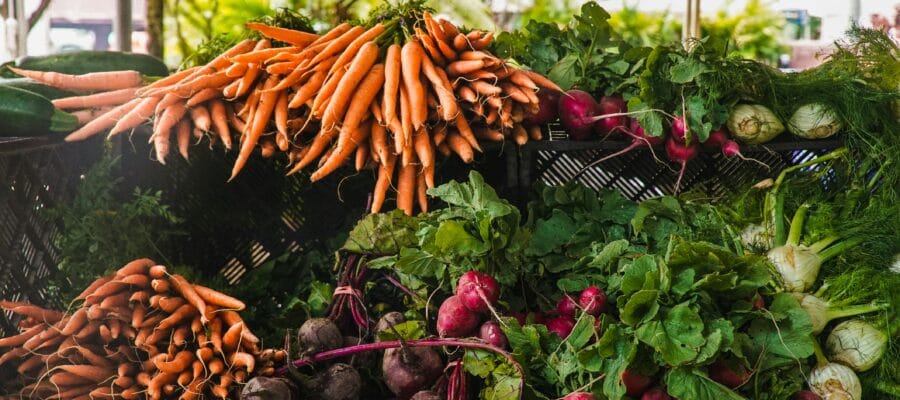Eating seasonally is not just a trend; it’s a savvy approach to nutrition and budgeting.This budget-friendly approach not only helps you save money but can also generate income if you’re savvy. By embracing nature’s rhythm, you’ll unlock a world of nutritious, affordable options that support local farmers and reduce your carbon footprint. Ready to transform your shopping habits and potentially earn from your newfound knowledge? Let’s dive into the ultimate guide to seasonal produce, packed with money-saving tips and income-generating ideas that will revolutionize your relationship with food.
Jump to...
Understanding Seasonal Produce
Seasonal produce refers to fruits and vegetables that are harvested at their peak ripeness during specific times of the year. These items are often more affordable due to their abundance and require fewer resources to grow and transport. Moreover, seasonal produce is typically more nutritious and flavorful, as it’s allowed to ripen naturally. To start your seasonal eating journey, consider using a seasonal food guide to learn what’s available in your area throughout the year.
Winter Wonders
Winter brings a bounty of hearty vegetables and citrus fruits. Root vegetables like carrots, parsnips, and potatoes are excellent choices for warming soups and stews. Citrus fruits such as oranges, grapefruits, and lemons provide a much-needed vitamin C boost during cold months. However, the variety of produce may be limited compared to other seasons, which could lead to menu fatigue if not carefully planned.
Spring Delights
As the weather warms, spring offers tender greens and early fruits. Asparagus, artichokes, and peas are at their prime, perfect for light, refreshing dishes. Strawberries and rhubarb make their appearance, ideal for desserts and preserves. The downside is that spring produce can be delicate and have a shorter shelf life, requiring more frequent shopping trips.
Summer Abundance
Summer is the season of plenty, with a wide variety of fruits and vegetables available. Tomatoes, cucumbers, and peppers are perfect for salads and grilling. Stone fruits like peaches and plums offer sweet treats. While the abundance can lead to great savings, it’s important to have a plan to use or preserve the produce before it spoils.
Fall Harvest
Autumn brings robust flavors with squashes, apples, and root vegetables. These hearty options are great for roasting and baking. Cruciferous vegetables like broccoli and Brussels sprouts are at their peak. The challenge can be transitioning from light summer meals to heartier fall dishes while maintaining variety.
Money-Saving Tips for Seasonal Eating
To maximize your savings when buying seasonal produce, consider these tips:
- Buy in bulk when prices are low and preserve excess through freezing, canning, or drying.
- Visit local farmers’ markets for the freshest produce at competitive prices.
- Join a Community Supported Agriculture (CSA) program for regular deliveries of seasonal produce.
- Learn to properly store different types of produce to extend their shelf life and reduce waste.
- Plan your meals around what’s in season to take advantage of lower prices and peak flavors.
Preserving Seasonal Bounty
To enjoy seasonal produce year-round and save money in the long run, consider these preservation methods:
Freezing
Freezing is an easy way to preserve many fruits and vegetables at their peak. It’s great for berries, peaches, and most vegetables. The downside is that it requires freezer space and some foods may change texture when thawed.
Canning
Canning allows you to preserve large quantities of produce for long-term storage. It’s ideal for tomatoes, pickles, and jams. However, it requires specific equipment and careful attention to safety procedures to prevent foodborne illness.
Drying
Drying fruits and herbs is a space-efficient preservation method that concentrates flavors. It works well for apples, berries, and herbs. The drawback is that it can be time-consuming and may require special equipment for best results.
Main Seasonal Produce per Month
| Month | Vegetables | Fruits |
|---|---|---|
| January | Carrots, Cauliflower, Cabbage, Kale, Beetroot | Oranges, Lemons, Kiwis, Pears, Clementines |
| February | Brussels Sprouts, Leeks, Parsnips, Turnips, Cabbage | Blood Oranges, Grapefruit, Kiwis, Lemons, Pears |
| March | Artichokes, Asparagus, Broccoli, Spinach, Spring Onions | Strawberries, Pineapples, Mangoes, Apples, Bananas |
| April | Peas, Asparagus, Radishes, Artichokes, Rhubarb | Strawberries, Apricots, Cherries, Limes, Pineapples |
| May | Asparagus, Peas, Zucchini, Spinach, Spring Onions | Strawberries, Cherries, Apricots, Peaches, Nectarines |
| June | Tomatoes, Cucumbers, Green Beans, Eggplant, Bell Peppers | Watermelon, Raspberries, Blueberries, Peaches, Plums |
| July | Corn, Tomatoes, Zucchini, Cucumbers, Green Beans | Blackberries, Watermelon, Cantaloupe, Figs, Nectarines |
| August | Corn, Eggplant, Tomatoes, Bell Peppers, Okra | Peaches, Plums, Figs, Blackberries, Melons |
| September | Pumpkins, Sweet Potatoes, Brussels Sprouts, Cauliflower, Broccoli | Apples, Grapes, Pears, Figs, Pomegranates |
| October | Pumpkins, Squash, Brussels Sprouts, Carrots, Parsnips | Apples, Pears, Grapes, Cranberries, Persimmons |
| November | Sweet Potatoes, Brussels Sprouts, Turnips, Squash, Kale | Apples, Pears, Cranberries, Pomegranates, Persimmons |
| December | Brussels Sprouts, Carrots, Parsnips, Turnips, Kale | Oranges, Grapefruit, Tangerines, Pears, Pomegranates |
Conclusion on Buying Seasonal Produce
Embracing seasonal eating is more than just a way to save money on groceries; it’s a lifestyle shift that can positively impact your health, wallet, and community. By following the tips outlined in this guide, you’ll not only reduce your food expenses but also open doors to potential income streams. Whether it’s starting a small market garden, offering seasonal cooking classes, or creating a popular blog about budget-friendly seasonal recipes, the possibilities are endless. Remember, every seasonal purchase is an investment in your well-being and local economy. So, the next time you’re at the grocery store or farmers market, let the seasons be your guide to smarter, more economical, and delicious eating. Your taste buds—and your bank account—will thank you!
